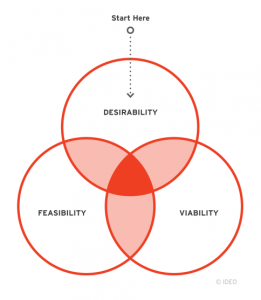What Will You Do When Robots & Watson Take Your Job? Design the Future and Redesign You

I just watched the YouTube video “Humans Need Not Apply.” After the initial let-down (boy do I feel useless – and apparently I soon will be), I had to stop & think. If 45% of human jobs will be replaced by bots (physical and virtual), and if that will happen in our lifetime — much more quickly than farm work was mechanized and craftsmen were replaced by factories — what should each of us do?
The video maintained (oops, the author maintained) that we will not create economies filled with poets & artists. I agree. However, when we combine (1) the way such artists sense, think, and work with (2) other disciplines like IT (or engineering, medicine, etc.) and (3) business (or social enterprise, government, etc.), we have a hugely effective way to do what will need to be done: finding needs and creating new ways to fulfil them.
 That very powerful design-thinking triad of (1) desirability, (2) feasibility, and (3) viability is a core concept at IDEO – the firm that basically created the modern mouse (the computer one), still in use decades later, as well as other innovative products & services, many of which you probably use & don’t think about. Think: shopping cart frames with lift-out baskets, Windows 8 eco-sensitive packaging (well, the box was good), Oral-B contoured toothbrushes, and AliveCore’s heart monitor (OK, you’d probably know if you were using that one).
That very powerful design-thinking triad of (1) desirability, (2) feasibility, and (3) viability is a core concept at IDEO – the firm that basically created the modern mouse (the computer one), still in use decades later, as well as other innovative products & services, many of which you probably use & don’t think about. Think: shopping cart frames with lift-out baskets, Windows 8 eco-sensitive packaging (well, the box was good), Oral-B contoured toothbrushes, and AliveCore’s heart monitor (OK, you’d probably know if you were using that one).
Many people get excited about a new technology or a new market but forget to focus first on the humans who will use what’s being offered to them. It’s best to start with what someone needs, then design what will work and what can economically be offered to them.
In fact, in these days of global, technologically-enabled business, what you design may be used by millions or billions of people (Facebook’s “like” button is used over 22 billion times each day) and generate millions or billions of dollars’ worth of business — a useful thing to do if bots are taking over jobs and industries with revolutionary efficiency.
Beyond a design focus and process, the model was also the basis for team design at Scient, a dot-com consultancy I worked for years ago which built the first eBusinesses for Chase, Boots, Johnson & Johnson, Marubeni, Sephora, and more. It’s easy to fill teams with friends and others like yourself. But it’s far more productive (read: businesses that actually succeed) if all three of these areas are covered, and if the team starts the creation process with the user.
Is the model only for design-process and designing teams? No. The real power of the model may not be in designing for humans, but in designing humans.
As you consider what to do in the new bot world (or even the pre-bot version), you’ll want to create a hard-to-replicate skillset — yourself, as a differentiated product. I’ve heard the recommendation to become a “T”-shaped person who combines broad expertise in many areas with depth in at least one. But what “areas”? Maybe it’s best to become an oddball with expertise in two or three of these balls.
In fact, we’re already seeing a trend towards “Renaissance” or “portfolio” careers, whereby someone might be an IT developer, jewellery designer, and Afghan women’s rights activist (like my friend). Or an investment manager & chef, trained in computer science. Many successful innovators take ideas from one field (e.g. mobile phone technology) and apply them in another (e.g. medicine — see PEEK, a smartphone app and eye-tracker developed for eye-care testing in Kenya). These innovators include both intrepreneurs (employees) and entrepreneurs.
Some of the career diversity occurs at the same time, via part-time work and freelancing. Some occurs over a lifetime, with “retirement careers” or “second- and third-careers.” Some of those careers are the result of a strong creative urge. Others are a personal crisis (see Martine Rothblatt on TED.com, who created a multi-billion-dollar-revenue company in satellite technology & radio, then switched to pharmacology, generating USD1.5 billion in revenues annually with a new drug). Still others are formed by systemic economic crises that throw people out of work, forcing them to find new jobs. I’ve experienced that myself, with US Defence Department budget cuts, the Asian Currency Crisis, the dot-com crash, and the 2008 global crash.
Just as global warming is creating more frequent and more extreme climactic crises, it seems that global economic connectivity is creating crises that are more frequent, widespread, and deep. And there’s another one — the bot one — to come.
So in some regard, maybe yes, we will be an economy filled with artists. But we’ll be artists who are at the same time technologists (or engineers, doctors, etc.) and businesspeople (or social entrepreneurs, freelancers, government leaders, etc.) and more.
I believe this is one reason why there’s a resurgence of interest in Design Thinking, and it’s yet another reason why I teach it and bring together cross-disciplinary teams. It’s yet another reason SP Jain admits chefs, photographers, IT programmers, and engineers, into our business programs, and why we think it’s valuable to bring current problems at students’ workplaces into classrooms filled with professionals from other industries, nations, and disciplines.
So, are we all sitting around bemoaning the loss of our farm jobs, in which early humanity was almost universally employed? No. Do we need to bemoan a future in which we can’t earn a living and there’s nothing to do? No. I believe we should instead celebrate the beginning of an age in which our needs will be met with far fewer resources, and in which we’ll have the time and technology to solve problems we’ve never been able to solve before. As long as humans have needs and desires, we will have something to do and something to trade. It’ll be a faster revolution than before, so we’ll have to prepare (or redesign) ourselves now.
How will you redesign you? And what will you create?
About the author: Dr. CJ Meadows, Director – i2i, the innovation & insights center
Dr. Meadows received her doctorate from Harvard Business School and has taught at several leading schools, including: INSEAD, Harvard, Singapore Management University and the National University of Singapore. Her background spans several areas of business expertise such as Leadership & Management, Strategy, Finance, Accounting, Investments & Business Development, Legal, IT, Marketing & PR and People Management.

